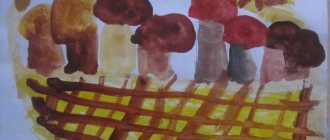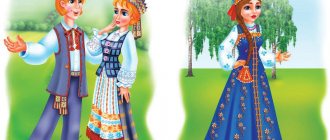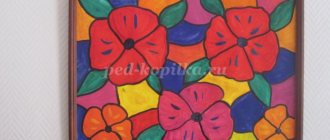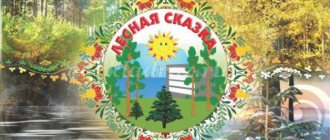Creative project in kindergarten “Wild and Domestic Animals”. Senior group
Project for children 5-6 years old on the topic: Animals
Description of the project: I offer you a creative project on the topic “Wild and Domestic Animals” for children 5-6 years old with special needs. This project will be useful for educators of all age groups, since on its basis they can continue working with children to study the above-mentioned topic. This project allows you to expand, consolidate and systematize children’s knowledge about domestic and wild animals, their characteristic features of appearance, life and behavior, their habits, and dependence on humans. Participants: children of the senior group with special needs of MBDOU "Kindergarten No. 98 of compensatory type" in Syktyvkar, parents, teachers and speech therapist. Type of project: creative, educational Duration of implementation: 3 weeks Form of work: group, frontal Goal: Expand, consolidate and systematize children’s knowledge about domestic and wild animals, their characteristic features of appearance, life and behavior, their habits, dependence on humans. Objectives: 1. To stimulate interest in project activities. 2. To consolidate and expand children’s knowledge and ideas about wild and domestic animals. 3. Foster a desire to take care of them. Cultivate a value-based attitude towards one’s own work, the work of other people and its results. 4. Develop logical thinking and the ability to make inferences. Develop the ability to construct statements such as reasoning. To develop and encourage children's cognitive activity and interest in learning new things. Progress of the project Problem statement: The teacher shows the children a magazine about animals. It asks the question, what or who is this magazine about? (children's answers). The teacher tells the children that in magazines about animals, the authors, before writing about any animal, learn a lot about it, study, research, and then write interesting and educational articles. Can you tell us about any animal? (children's answers) Solving the problem (indicating the child's goal) Do you want to learn more about animals? (children’s opinion) To do this, we need to learn, do and know a lot. What or who can help us with this? (answer options) (Magazines, encyclopedias, books, a trip to the zoo, animal exhibitions, stories from parents, etc.) Preparatory stage: 1. Conversation with parents about making an album page about animals together with their children. 2. Prepare collections, encyclopedias, magazines about animals. 3. Prepare didactic games and tasks on the lexical topic. 4. Recommendations for parents: visit the “Living Corner” at Yunnatov Station. 5. Reading literary works. Project implementation: Educational activities: Lesson on the world around us on the topic “Our smaller friends.”
Goal: To expand and generalize children’s knowledge and ideas about domestic and wild animals, their appearance, habitat, methods of movement, and nutrition.
Lesson on speech development (using a mnemonic table) on the topic “Cow”.
Goal: To develop the ability to recite a poem based on a diagram-drawing.
Lesson on speech development (using a mnemonic table) on the topic “Squirrel”.
Goal: Continue to develop the ability to compose and tell short stories based on a drawing diagram.
Application (by tearing method) on the theme “Hare”.
Goal: To consolidate the method of cutting, the ability to fill the entire contour of the image.
Modeling on the theme “Fox, Wolf”.
(optional) Goal: To develop the ability to convey the body proportions and movement of an animal in sculpting.
Design from paper, cardboard, sleeves on the theme “Hare” (children’s choice)
Purpose: To develop the ability to create a familiar image using familiar techniques when working with paper
Design from paper (origami with applique elements) on the theme “Pets” of your choice.
Goal: Continue to develop children’s ability to create crafts using the origami technique, based on a sample and a diagram of the sequence of work.
Design from paper (origami with applique elements) on the theme “Animals of our forest” of your choice.
Goal: To continue to develop children’s ability to create crafts using the origami technique, based on a sample and a diagram of the sequence of work.
Drawing on the theme “My favorite pet.”
Goal: To develop children’s ability to depict a familiar image of an animal (“Cow”, “Donkey”, “Cat”, “Pig”) based on a sample and a drawing diagram.
Drawing on the theme “Who lives in our forest.”
Goal: To develop children’s ability to depict a familiar image of an animal (“Hare”, “Squirrel”, “Hedgehog”, “Fox”) based on a sample and a drawing diagram.
Joint activities of the teacher and children: 1. Conversations with children: “My pet”, “Animals of our forest” 2. Examination of pictures and illustrations in magazines, encyclopedias, reference books about animals. 3. Observations and conversations with dogs being walked by their owners. Discussions about breed diversity. 4. Riddles and answers 5. Reading fiction: “The Living Hat” by N. Nosov, “How a Donkey Searched for Happiness” by E. Karganova, “How a Wolf Was a Mother to a Calf” by M. Lipskerov, “Wintering of Animals” Russian folk tale, “Cat in boots" by Ch. Perrault, "Little Red Riding Hood" by Ch. Perrault, "My Gray Friend", "Stray Cat" by B. Zhitkov 6. Drawing mnemonic tables based on the teacher's example and the drawing diagram "Cow" based on the poem, "Squirrel" according to the story. 7. Theatrical activity “Winter quarters of animals” from toys and crafts made by parents.
Independent activities for children: 1. Coloring pages on lexical topics. 2. Work on the cells in notebooks (following the model). 3. Magnetic drawings by cells (according to the sample). Games and tasks as recommended by the speech therapist. Sensory development:
“Assemble the picture”, “The fourth odd one”, “Prostokvashino”, “Horses” (puzzles), “Long or short?”, tasks on the sheets “Connect the dots”
Lexico-grammatical games and exercises:
“Name the baby affectionately ”, “Who was who?”, “Who has who?”, “Who is running after whom?”, “What does who have?”, “Who will be who?”, “Guess and repeat”, “Who is playing with whom? ", "How many cubs?", "Who did you see in the forest?"
Development of coherent speech:
the story “Naida”, reading and retelling “The Bug and the Cat”, a story based on supporting pictures “Who spends the winter?”
The sound side of speech:
“Find the common sound”, “Finish the word”, “What word did you get?”
Finger gymnastics:
“Guess the tongue twister”, counting rhyme “Goat”, finger gymnastics “Hares”, “In the deep forest”
Joint activities of parents with children: 1. Observation and conversation about domestic and wild animals (What are the similarities and what are the differences?) 2 Drawing (together with children) on the topic “Animals that I saw.” 3. Making an album that reflects poems, riddles, counting rhymes, sayings, crafts and drawings. 4. Making a toy-craft using the origami method to play out the fairy tale “Winter Hut of Animals”. 5. Completing tasks of the speech therapist teacher in notebooks and folders on a lexical topic. Project result: The project “Domestic and Wild Animals” achieved its objectives. The results indicate changes in children’s understanding of domestic and wild animals; children learned to distinguish between characteristic features of appearance and convey them in creative activities, learned the life and behavior of animals, their habits, dependence on humans, and also learned to compose short stories from personal experience. During the implementation of the project, joint partnership activities between educators, children and parents emerged. Parents gained experience that allows them to help their children successfully adapt to the new Federal State Educational Standards for Preschool Education in the process of preparing for school. Creative works of children within the framework of the project: Albums “Wild Animals” and “Domestic Animals” made by parents and children within the framework of the project:
We recommend watching:
Project in kindergarten for older preschoolers 5-7 years old on legal topics Educational creative project in the senior group on the topic: Insects Project for children in the senior group on the topic “Fauna and flora of their native land” Project on the topic “Russian folk tales” in kindergarten in the senior group
Similar articles:
Project for children of the senior group “Our cheerful garden”





